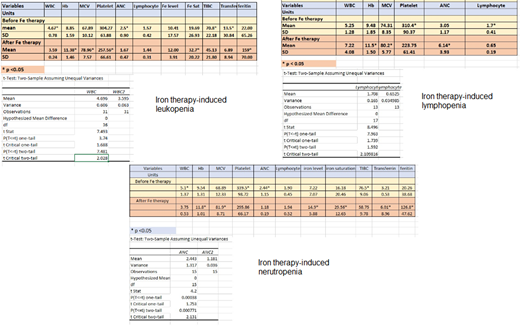Introduction
Iron deficiency anemia (IDA) is the most common cause of anemia in both developed and developing countries, particularly affecting females in the child bearing age and children.
The treatment of IDA is a major health goal, it consists of treating the underlying cause and iron supplements.
Iron replacement comes in form of oral or intravenous, there are certain side effects of this therapy including constipation and allergy.
Leukopenia as a side effect of iron therapy is under reported in the literature as only sporadic cases were prescribed.
We conducted a study to clarify this issue and to check for its clinical significance.
Objective:
To assess the relationship between iron therapy (intravenous) and leukopenia, neutropenia or lymphocytopenia, and its impact on patient's clinical settings.
Materials and Methods
We retrospectively reviewed the electronic medical records of patients attended Haematology clinic for iron deficiency anemia and treated with intravenous iron (ferric carboxymaltose or iron saccharide) over 2 years in Hamad Medical Corporation, Doha/Qatar.
Adult female patients with IDA cases who received IV iron were included. anemia due to other nutrients deficienciesa nd conditions (including other medications) that may alter WBCs count were excluded.Age, Ethnicity, BMI, Complete blood count and iron studies data were collected before and after treatment with IV iron therapy. Infection occurrence at the time of IDA and leukopenia, the use of antibiotics and infection related complications were also collected. Leukopenia was defined as WBCs count to be less than 4000/microlitre, Neutropenia as ANC less than 1500/microlitre and lymphocytopenia as lymphocytes less than 1000/mocrolitre.
Statistical analysis was done using mean , SD and t test.
Results
After iron therapy, out of 1567 case of iron deficiency anemia, 30 cases (1.914%) have leukopenia,15 cases (0.957%) have neutropenia and 12 cases (0.765%) have lymphocytopenia. All had normal readings before treatment.
2 patients (6.66%) had infection, 1 had upper respiratory tract infection and 1 urinary tract infection, the latter was treated with antibiotics, none reported infection related complications
Discussion
Leukocytopenia is defined as low WBCs circulating in the blood and this can be caused by low neutrophils count, low lymphocytes count, other WBCs components or combined.
Some previous reported cases generated the idea of a possible connection between iron supplement therapy and leukopenia, Brito-Babapulle et al reported a case of fatal bone marrow suppression linked to ferric carboxymaltose therapy in a patient with IDA. The pathophysiology is not well understood but thought to be a toxic effect of iron on bone marrow and it can affect all cell lineages. Our findings suggest possible iron replacement side effect as there was significant drop of the WBCs count after treating IDA patients with IV iron, however this association was not common.
There was no life threatening or serious infections in the affected patients, which can suggest that most of these cases are mild and transient.
More studies are needed to address this issue, particularly on larger scales.
Patient education also may be appreciated before treatment with IV iron.
Conclusions:
Leukopenia in form of neutropenia or lymphocytopenia maybe a side effect of IV iron therapy. Clinical significance is limited in view of current literature further studies needed to elaborate more in this important adverse event.
No relevant conflicts of interest to declare.
Author notes
Asterisk with author names denotes non-ASH members.


This feature is available to Subscribers Only
Sign In or Create an Account Close Modal